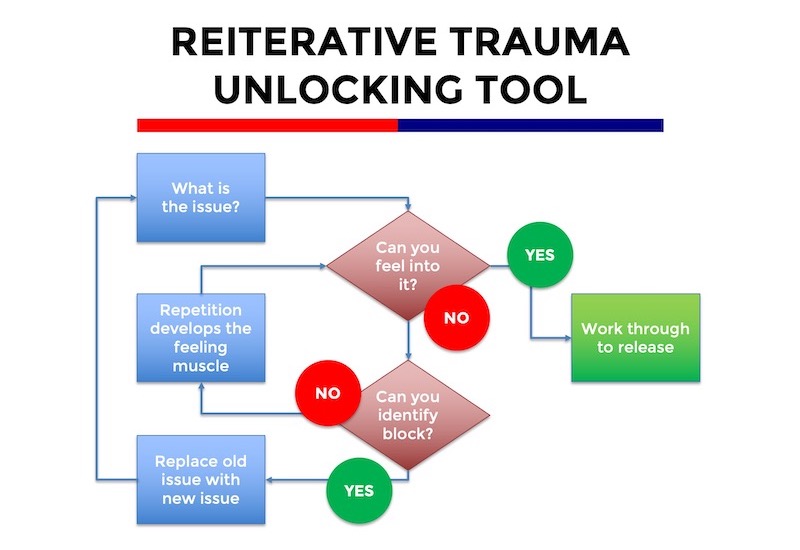The Reiterative Trauma Unlocking Tool
- 11 March 2025
- Posted by: Michael H Hallett
- Category: Generational trauma , How-to & step-by-step ,

I tried, honestly. I tried to make up a catchy acronym that accurately conveyed what this thing does. I’ve ended up with RTUT—the Reiterative Trauma Unlocking Tool—which I admit is neither sexy nor even particularly pronounceable.
But there we go… it is what it is.
What is this weirdly named unlocking tool?
The Reiterative Trauma Unlocking Tool is a simple process flowchart for handling situations where we’ve identified some kind of psychic block but can’t clear it.
This can be a bit deflating and discouraging, making us feel stuck.
The reason we can’t clear a block is because something else is blocking it.
We must therefore shift our attention to whatever’s blocking the block and see if we can release that. Of course, it may itself be blocked by something else—thus the reiterative nature of this tool, which identifies the highest-level block to be unlocked.
Here it is.

Very pretty. But how does it work?
Using the Reiterative Trauma Unlocking Tool
- Start with the issue you’re aware of. Your awareness may be vague, only a feeling, without any clear articulation—that’s fine. Or you may have a clear mental sense of what you’re dealing with.
- Find a quiet, undisturbed space. Stay hydrated. Breathe slowly and deeply. Feel into the issue. Keep your awareness on your heart area. Resist any temptation for your mind to take over and analyse to death. Whatever happens, do not judge.
- Can you feel into the block? This could manifest in various ways. An awareness of an energy, or of entering a space where an energy is watching. An energy being present but then withdrawing, like a lizard slipping under a stone. You may hear words or sense something about the nature or origins of the block.
- The issue may yield. This might feel like something melting or shattering. You may find that a dialogue is possible. Ask: “what do you need?” Remember to not judge. Let the process take its own time. You may need to return several times to fully unlock the issue. You’ll know when it’s done, both by feeling lighter and most likely gaining insight into the situation.
- If the issue doesn’t yield, ask yourself what’s blocking it. You may feel the block without having to think about it. Spend some time with your awareness resting on the block to see what you can discern about it.
- If you can identify the block, whether it’s just with a nameless feeling or with a clear mental identification, make that your primary issue. Return to the start of the flowchart (Step 1) and go again.
- If you can’t identify the block, spend more time feeling into it. This may feel like a closed look (stuck/going nowhere) but it isn’t. The more we practice feeling, the more our ability to feel—and decode our feelings—develops. Keep coming back, always without judgment, and the block must eventually yield.
Example
Let’s say your genealogy research has uncovered some kind of painful wrinkle in your family’s past, which you suspect is affecting you now. You feel into the issue but hit a dead wall of numbness.
You can become discouraged and give up or consider why you’ve hit a wall. You realise that you’re actually trying to think what the issue is, rather than feel what it is.
Then you decide to consciously connect to your heart and approach the issue from there. Yet when you try it, you find that access to your heart is also walled off and numb.
So, you shift your attention from your heart to the numbness itself and spend some time feeling into that. Eventually, a subtle feeling emerges—a creeping, cringing feeling of shame. There’s something down here that someone was deeply ashamed of.
The Reiterative Trauma Unlocking Tool has looped you around to the place where you need to start work on this issue.
Once you have a clearer path, try using the 7 Steps to clear emotional blocks.
Photo by Tine Ivanič on Unsplash
